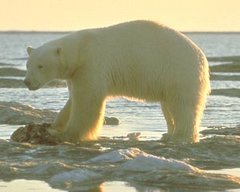Polar Bear
The Polar Bear (Ursus maritimus), also known as White Bear or Northern Bear, is a large bear native to the Arctic. It is the largest land carnivore species. It is the apex predator within its range. more...
It is well-adapted to its habitat: its thick blubber and fur insulate it against the cold, its white color camouflages it from its prey, and it hunts well both on land and in the water.
Natural range
The Polar Bear is a circumpolar species found in and around the Arctic Ocean whose southern range limits are determined by pack ice (their southernmost point is James Bay in Canada). While their numbers thin north of 88 degrees, there is evidence of Polar Bears all the way across the Arctic.
Their main population centers are:
- Wrangel Island and western Alaska
- Northern Alaska
- Canadian Arctic archipelago
- Greenland
- Svalbard-Franz Josef Land
- North-Central Siberia
The destruction of its habitat on the Arctic ice by global warming threatens the bear's survival as a species; it may become extinct within the century. Signs of this have already been observed at the southern edges of its range . There have been no proposals to date to transplant the species to some other environment, such as Antarctica.
Size and weight
The largest extant land carnivore, twice the size of a tiger and weight of a lion, adult males weigh from 400 to 600 kg (900 to 1300 lb) and occasionally exceed 800 kg (1750 lb). Females are about half the size of males and normally weigh 200–300 kg (450 - 650 lb). Adult males measure 2.4 to 2.6 m (7' 10" to 8' 6"); females, 1.9 to 2.1 m (6' 3" to 6' 11"). At birth, cubs weigh 600 to 700 g. Population estimates range from 16,000 to 35,000, with about 60% in Canada.
Subspecies
It is generally believed that there are no living Polar Bear subspecies . In fact because "olar bears bred with brown bears have produced fertile hybrids" it can be argued that Polar Bears are a subspecies of Brown Bear.
The number of distinct populations depend on who is counting. The IUCN/SSC Polar Bear Specialist Group ("PBSG"), the preminent international scientific body for research and management relating to Polar Bears, currently recognizes twenty populations, or stocks, worldwide . Other scientists recognize six distinct populations, but no subspecies:
- Chukchi Sea population on Wrangel Island and western Alaska
- Northern and northwestern Alaska and northwestern Canada (the Beaufort Sea population)
- Canadian Arctic archipelago
- Greenland
- Spitzbergen-Franz Josef Land
- Central Siberia
Other sources list these subspecies: Ursus maritimus maritimus Ursus maritimus marinus .
Fur and skin
The nose and skin are black. The fur is whitish in appearance; pure white after molt, yellowish in summer due to oxidation by sun, and sometimes greenish (due to algal growth inside the shaft of hollow guard hairs) in captive bears kept too warm. This fur is good camouflage as well as insulation. The bear is often thought to cover its visible black nose while hunting, though no scientist has observed this. They will, however, cover their muzzles while sleeping, probably for insulation. Stiff hairs grow on the soles of its paws; these insulate and provide traction on ice.
Read more at Wikipedia.org




